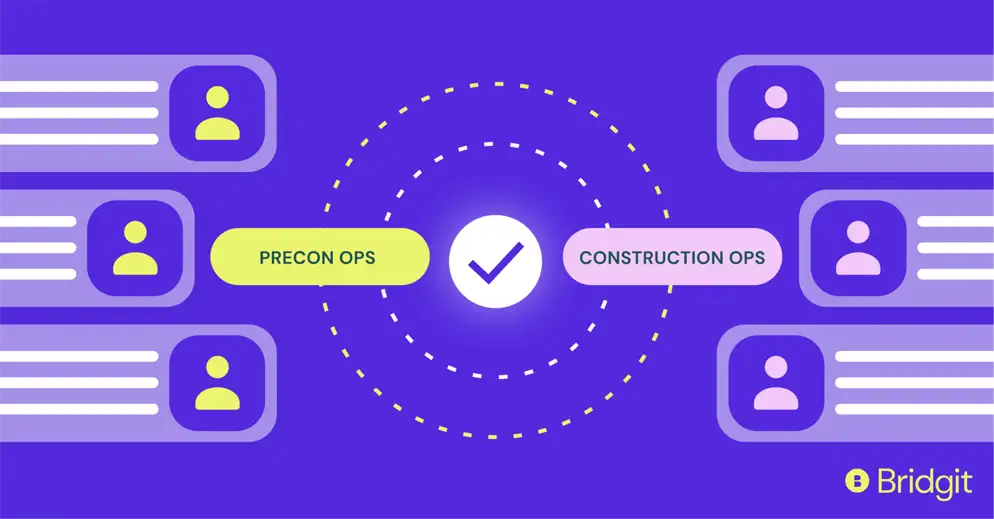Table of Contents
Traditionally, the construction sector has favored a siloed approach to its teams, with each one keeping its cards close to the chest. This defensiveness is worth questioning, especially as building methods evolve and the industry gets better acquainted with new technologies. Is operating in silos still an effective strategy, particularly when it comes to planning your most valuable resource – your people?
The critical question we want to ask is this: “Why do we need to bridge the gap between preconstruction and construction operations when it comes to people planning?” Preconstruction and ops? Bridging the gap? It’s a counterintuitive question, given the industry’s preference for compartmentalization.
This article will explore the potential benefits of bridging the gap between preconstruction and construction operations.
Closing the gap from precon to construction
Carrying on tradition: siloed preconstruction and construction operations
In construction, teams are separated by project phases, each focusing on specific tasks and maintaining information within their unit. It’s rooted in the desire to maintain control and oversight within each team, aiming to minimize risk and errors.
However, this approach may not always promote the most efficient and effective use of resources. When each team works in its silo, it leads to a lack of communication and collaboration between different phases of a project. This isolation can hinder the flow of critical information, stifle innovation, and even result in duplicated effort.
The siloed approach to workforce planning can lead to significant challenges. If the preconstruction team operates separately from the operations team, it becomes difficult to anticipate the staffing needs of upcoming projects. This disjointed planning can result in inadequate or overstaffing, which has significant cost and efficiency implications.

Use your workforce data to create a competitive advantage
Download our white paper to see how effective workforce planning can help stay ahead of labor demands and create a strategic project pipeline.
The case for collaborative workforce planning
Now, we’re not making the case that you merge preconstruction and construction operations; they’re still distinct components of the construction process and should remain that way. What we are saying, though, is that there should be increased visibility across the project team, so handoff between teams is simplified both ways.
Collaborative workforce planning emphasizes the value of shared knowledge and cross-team communication. It ensures everyone involved in a project, from inception to completion, is on the same page. This unity is particularly beneficial for pursuit planning – identifying and allocating resources to potential future projects.
By facilitating the early involvement of all stakeholders, you’ll get a comprehensive picture of the project’s resource requirements, timelines, and potential challenges.
Furthermore, this integrated approach to workforce planning provides a proactive method for anticipating resource needs. Instead of reacting to resource shortages or surpluses when they occur, your teams can plan ahead, aligning your staffing strategies with project timelines and goals.
The next question is, what tools can we use to build this bridge between preconstruction and construction operations?
A solution to integrate preconstruction and construction operations
Common workforce planning tools like spreadsheets or generic planning software usually serve to embed teams deeper into silos. They lack visibility, and one or two people are confined to updating them. If there are any changes to a job, a time-consuming manual update is required.
Luckily, workforce planning tools like Bridgit Bench are specifically for the construction industry. It offers a centralized platform where preconstruction and operations teams can seamlessly assign people to tasks, manage timelines, and track resource utilization. It consists of two primary modules – Precon and Operations – each designed to enhance visibility and efficiency in their respective stages.
In the Precon Module, you can define tasks, assign individuals to those tasks, and adjust timelines as required. One key advantage of this feature is the ability to monitor the utilization of resources in real-time, ensuring that no person is underutilized or overstretched.
The Operations section allows you to plan your workforce for ongoing projects and pursuits. The tool’s intuitive design makes it easy to find the right person for the right project at the right time, expediting decision-making.
One of the fundamental problems with workforce planning in construction is getting out of a reactive, short-term mindset and into a long-term strategic one. And this isn’t your fault; it’s the tools you use. Spreadsheets cannot give you long-term insight into the capacity of your people in the medium to long term.
But when both preconstruction and operations planning are managed in Bridgit Bench, the result is unprecedented visibility of your workforce plan across short and long-term timelines. You’ll get insights into how different pursuits are developing, enabling you to better plan for upcoming projects and accurately forecast if additional resources are required. Bridgit Bench’s flexibility ensures that projects aren’t only well-resourced from the get-go but adapt dynamically as they evolve.
The central question we started with—”Why do we need to bridge the gap between preconstruction and construction operations when it comes to people planning?”—is now easier to answer. By fostering collaboration and open communication between preconstruction and operations teams, you’ll improve project visibility, enhance efficiency, and enable accurate forecasting. This integration leads to better personnel management and improves project outcomes and success.
Tools like Bridgit Bench facilitate this shift towards integrated workforce planning. By providing a centralized platform for preconstruction and construction operations planning, you can break down traditional silos and foster seamless collaboration.


